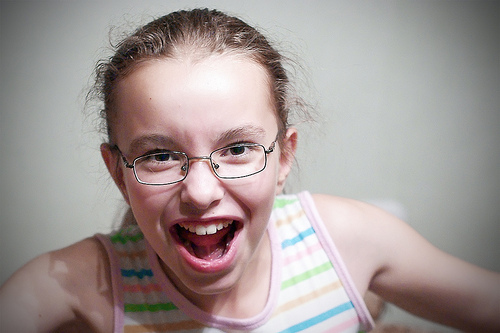
Before writing anything about visual difficulties in Beijing, I wanted to double-check my facts with a professional. The Canadian optometrist I wrote to responded with the following:
“Neurologically the eyes do not finish developing until a child reaches 6 to 7 years old … which means that the neural pathways are still developing until that time. The concern here is more with binocular vision rather than developing myopia. Both eyes have to see equally well and be used together so that there is equal development right and left eye. If one eye turns (strabismus) or one eye has a high refractive error that eye can become lazy (amblyopic).
Your concern with young children working with fine detail for prolonged periods of time is well founded as there is some evidence through studies to support that there is higher degrees of myopia in populations that promote this. China is sited in the studies as a country with higher degrees of myopia in the higher populated centers where there is greater competition for children to succeed so there is higher demand placed on the children to study from a very young age.
Very recent research suggests that myopia is related to the focusing of the eye to continuous near work for long periods of time. It has to do with central vision and also with peripheral vision when the eye is focusing. It was interesting how the incidence of higher myopia was concentrated in the higher populated cities (like Beijing) but is dramatically less in the outlying areas.
There is a link between lesser amounts of myopia and longer periods of exposure to sunlight. It has to do with Vitamin D absorption but I’m sure there is also a connection to the longer distance focus when outdoors. In practice there is no doubt that farmers have better distance vision than most computer programmers.”
It seems she has said it all. To have good vision, kids need less time on up-close paperwork and time outdoors.
The reality in Beijing is that Chinese parents WILL start their child in academics at an early age. The solution might be to make sure early skills are taught from flash-cards in LARGE print held further from the child. Early printing tools – pencil and paper should also be LARGE. South Korea produces a wonderful type of smooth, wide, triangulated pencil that is easy for young children to work with and that helps promote a comfortable grip. I found none of this suitable type of tool in either Suzhou or Beijing. (Luckily, a kind Korean mother at the Suzhou-Singapore International School realized my appreciation of the Korean pencils and provided a few dozen as a parting gift. These were well received by my Shijicheng students; some parents balked at such "babyish" implements and remained proud of their 4-year-old being able to print in very tiny letters).
Save the eyes. Super-size it!
Ann Thompson is a veteran Canadian Special Education teacher whose long career has taken her to six countries (including Finland, the UK, and China). She holds a B.Ed. from the University of the West Indies in Jamaica, and a diploma in Special Education at McGill University. During her recent three years in China, she taught in an International School in Suzhou before coming to Beijing to develop an English program specifically suited to the needs of young Chinese children. She remains vitally interested in education and is developing a tutoring service. She continues to share her thoughts on her blog, www.thoughts.com/anedu/blog.



